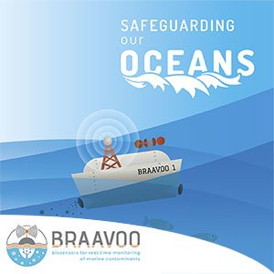Home > Press > BRAAVOO will design an unmanned surveying vessel and marine buoy that carry biosensors to monitor marine pollutants
 |
Abstract:
BRAAVOO will enable low-cost real-time measurements and has the potential to simplify marine environmental monitoring. The team led by CSIC Research Prof. Laura M. Lechuga, partner of the project and Group Leader at ICN2, is especially involved in the implementation of nanoinmunosensors based on a technology patented and licensed through CSIC by the ICN2 Group.
BRAAVOO will design an unmanned surveying vessel and marine buoy that carry biosensors to monitor marine pollutants
Barcelona, Spain | Posted on November 12th, 2014As a result of multiple man-made pressures, there is a slow but steady degradation of marine water quality, both chemically and biologically. The European Project BRAAVOO (Biosensors, Reporters and Algal Autonomous Vessels for Ocean Operation) was launched in December 2013 as part of the EU strategies to mitigate this problem. The initiative is coordinated by Prof. Jan van der Meer from the University of Lausanne's Department of Fundamental Microbiology.
It comprises 9 partners from 7 different countries, and includes four research groups specialised in biosensor strategies and 5 different small or medium-sized enterprises (SMEs). The Institut Català de Nanociència i Nanotecnologia (Catalan Institute of Nanoscience and Nanotechnology - ICN2) holds a BRAAVOO meeting on November 13-14, hosted by CSIC Research Prof. Laura M. Lechuga, partner of the project and Group Leader of the ICN2 Nanobiosensors and Bioanalytical Applications Group.
BRAAVOO aims to develop unmanned surveying vessels and buoys, which will travel on the surface of the seas carrying 'Lab-in-a-Chip' modules for real-time monitoring of marine contaminants. The sensor modules will include all optical elements for biosensor signal detection, microelectronics for data storage, and microfluidics for automatic, programmable sample analyses. Biosensors are highly efficient and cost-effective tools, making the project an innovative solution for real-time in-situ measurement of high impact and difficult to measure marine pollutants. The project has the potential to simplify marine environmental monitoring, a complex logistical task ultimately carried out nowadays in expensive laboratories far away from the seawater.
The concept of BRAAVOO is based on a unique combination of three types of biosensors, which will enable both the detection of a number of specific marine priority pollutants and also of general biological effects that can be used for early warning. The Group led by Prof. Laura M. Lechuga is especially involved in the implementation of nanoinmunosensors based on a technology patented and licensed through CSIC by the ICN2 Group. These sensors facilitate the direct detection of molecular interactions between specific antibodies and the pollutant substances.
The consortium gathered at ICN2 unites expertise and access to relevant infrastructure and development for the entire range of necessary experimental methods (from maritime engineering to microbiology and nanotechnology). Molecular microbiologists, electrical engineers, chemists and marine biologists will validate the biosensor-derived measurements in real-life mesocosm settings.
####
For more information, please click here
Contacts:
Àlex Argemí
Phone: 937372607
Copyright © ICN2
If you have a comment, please Contact us.Issuers of news releases, not 7th Wave, Inc. or Nanotechnology Now, are solely responsible for the accuracy of the content.
| Related News Press |
News and information
![]() Researchers develop molecular qubits that communicate at telecom frequencies October 3rd, 2025
Researchers develop molecular qubits that communicate at telecom frequencies October 3rd, 2025
![]() Next-generation quantum communication October 3rd, 2025
Next-generation quantum communication October 3rd, 2025
![]() "Nanoreactor" cage uses visible light for catalytic and ultra-selective cross-cycloadditions October 3rd, 2025
"Nanoreactor" cage uses visible light for catalytic and ultra-selective cross-cycloadditions October 3rd, 2025
Marine/Watercraft
![]() Strain-sensing smart skin ready to deploy: Nanotube-embedded coating detects threats from wear and tear in large structures July 15th, 2022
Strain-sensing smart skin ready to deploy: Nanotube-embedded coating detects threats from wear and tear in large structures July 15th, 2022
![]() A sunlight-driven “self-healing” anti-corrosion coating May 27th, 2022
A sunlight-driven “self-healing” anti-corrosion coating May 27th, 2022
![]() Quantum tech in space? Scientists design remote monitoring system for inaccessible quantum devices February 11th, 2022
Quantum tech in space? Scientists design remote monitoring system for inaccessible quantum devices February 11th, 2022
Announcements
![]() Rice membrane extracts lithium from brines with greater speed, less waste October 3rd, 2025
Rice membrane extracts lithium from brines with greater speed, less waste October 3rd, 2025
![]() Researchers develop molecular qubits that communicate at telecom frequencies October 3rd, 2025
Researchers develop molecular qubits that communicate at telecom frequencies October 3rd, 2025
![]() Next-generation quantum communication October 3rd, 2025
Next-generation quantum communication October 3rd, 2025
![]() "Nanoreactor" cage uses visible light for catalytic and ultra-selective cross-cycloadditions October 3rd, 2025
"Nanoreactor" cage uses visible light for catalytic and ultra-selective cross-cycloadditions October 3rd, 2025
Environment
![]() Researchers unveil a groundbreaking clay-based solution to capture carbon dioxide and combat climate change June 6th, 2025
Researchers unveil a groundbreaking clay-based solution to capture carbon dioxide and combat climate change June 6th, 2025
![]() Onion-like nanoparticles found in aircraft exhaust May 14th, 2025
Onion-like nanoparticles found in aircraft exhaust May 14th, 2025
![]() SMART researchers pioneer first-of-its-kind nanosensor for real-time iron detection in plants February 28th, 2025
SMART researchers pioneer first-of-its-kind nanosensor for real-time iron detection in plants February 28th, 2025
|
|
||
|
|
||
| The latest news from around the world, FREE | ||
|
|
||
|
|
||
| Premium Products | ||
|
|
||
|
Only the news you want to read!
Learn More |
||
|
|
||
|
Full-service, expert consulting
Learn More |
||
|
|
||








